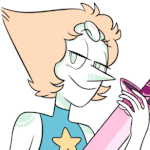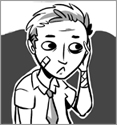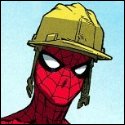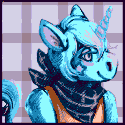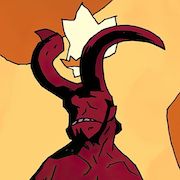|
If you're trying to work on drawing fundamentals, don't use a Wacom. The slick surface and constrained working area are only going to make things harder than they should be.
|
|
|
|

|
| # ? Jun 2, 2024 01:00 |
|
So I figured maybe getting some direction from this thread would inspire me to draw on a more regular basis. I did a bunch of quick 30 second gesture drawings (I have two dozen pages of these but this is the most recent page and I'm not about to photograph all of them), references here.  I did a few longer ones, reference for this one is  here here I also tried to make a more fully-realized figure drawing; reference is some picture of Lindsay Stirling 
|
|
|
|
I'm still looking for good resources or tutorials for learning how to fill in hair and shadows with closely spaced parallel lines (hatching) and any links would be sorely appreciated!
|
|
|
|
Note Block posted:I'm still looking for good resources or tutorials for learning how to fill in hair and shadows with closely spaced parallel lines (hatching) and any links would be sorely appreciated! This is definitely my bailiwick. Are you trying to do something like these?   I block out the shadows as contour drawings first and don't do more than minimal hatching outside the areas I marked off that way to make sure I don't go overboard with it. I like leaving those contours in because I think closing off the hatching makes it read more clearly as shadows, at least on cleaner textures like skin and cloth. Hair's a way more chaotic thing because your hashmarks are doubling as contours, so you can get a lot of mileage out of clumping the endpoints of your lines together or putting minor variations in contour to imply shape (rather than using perfectly rigid, uniform hatching). You can also get a lot out of the occasional bit going against the grain with hair, but you have to be careful about hatching too aggressively in opposing directions right next to each other or it'll become visually confusing - you generally shouldn't hatch on both sides of a contour line, for example. By far the most important thing with any kind of hatching, though, is not overdoing it. In highly textured areas like hair and in areas with high tonal contrast, you can afford to get very detailed with variation in your crosshatching - that's why I can do things like put three different shades of hatching in around the eye folds, for example. In lower-contrast areas you want to be a lot more sparing with them, even if the object itself is meant to be darker. Hatch marks are way better at showing contrast between adjacent areas than at showing objective shades of dark and light. (That's why the clavicle in the first drawing here looks so off.) Especially with hair, there should always be parts of it that have no hatching at all, just sparing contour lines to show flow. Generally speaking, the more uniform and dense the lines, the more it'll read as shading, while looser lines will look more like textures. Striking a balance between the two needs is mostly just a practice thing (as is doing dense, uniform hatching in the first place).
|
|
|
|
How do you guys construct complicated mechanical objects? Stuff like planes and what not. I can never seem to get them quite right. Since I'm a 3D artist I've considered making simple forms out of primitives in Max for reference but I'm not sure whether that'd be any help.
|
|
|
|
Scott Robertson is the chief of that stuff. His stuff mostly costs, especially his basic construction stuff, but there's some on the net for free too. See his Youtube channel, including stuff like: https://www.youtube.com/watch?v=E6myAjeebHU These are the basics of one of his methods: http://forums.sijun.com/viewtopic.php?p=272300
|
|
|
|
I have this bookmarked - I'm not sure if it's what you're looking for, but it might help. It talks briefly about getting to grips with individual joints and gears, but might be too concept/design orientated, as opposed to actual construction. Warning: Mecha
|
|
|
|
duralict posted:This is definitely my bailiwick. Are you trying to do something like these? Thank you so much duralict! I really appreciate your response and I'm looking forward to trying some of your advice out this weekend.
|
|
|
|
Disproportionation posted:How do you guys construct complicated mechanical objects? Stuff like planes and what not. I can never seem to get them quite right. Since I'm a 3D artist I've considered making simple forms out of primitives in Max for reference but I'm not sure whether that'd be any help. Feng Zhu has a huge amount of free tutorials on his site here: http://www.fengzhudesign.com/tutorials.htm Episode 28 Part 1 and 2: Vehicle Sketching, and Episode 33 Part 1 and 2: Mech Design are probably the ones you'd want to check out first.
|
|
|
|
What am I supposed to be actually taking away from gesture drawing? It's getting me no closer to being able to do a human body from scratch. I can't pose for poo poo without a reference, it's all very rigid.
|
|
|
|
Suzuki Method posted:What am I supposed to be actually taking away from gesture drawing? It's getting me no closer to being able to do a human body from scratch. I can't pose for poo poo without a reference, it's all very rigid. My understanding is that gesture drawing are to help you capture the life and motion of a body, not necessarily to teach you how to draw something accurately. It will help your drawings of a human body from scratch be interesting and dynamic instead of awkward or rigid. Also keep in mind the timing of the lesson changes what you learn to a extent. 30 second drawings always feel to be more about flow, while 2 minute drawings give you more time to also capture the volume of the different parts of the body. ShimmyGuy fucked around with this message at 03:07 on Oct 10, 2013 |
|
|
|
Suzuki Method posted:What am I supposed to be actually taking away from gesture drawing? It's getting me no closer to being able to do a human body from scratch. I can't pose for poo poo without a reference, it's all very rigid. Well, historically, you'd pretty always be working from life (or sketches from life). Working from memory or imagination is a pretty modern concept... Drawing stuff can be complicated, and in trying to draw something you're looking at, it's easy to lose the forest for the trees and get lost in getting every detail right, only to end up with something that has details, but has lost all of its sense of being (not to gang up on Blue Star, but case-in-point, until recently). Gestures teach you that form is god, fluidity is a blessing, something doesn't have to be exact to be correct, and hinting can be much more effective than detailing.
|
|
|
|
The idea behind gestures is to capture the action of the figure, with the intention to use that as the groundwork to establish the form of the figure afterwards. It's the first step in an incremental process. If your poses appear stiff or off in some way, then chances are the gesture is incorrect. It's a basic fundamental that you need to learn if you want your drawings to appear more lifelike, so I recommend you keep at it. If you're looking for reading material to help you better understand gestures, I highly recommend the Vilppu drawing manual, as it's the clearest and most concise introduction to figure drawing that's written in such a way that it's approachable to all skill levels in my opinion. Other good books include Figure Drawing for All it's Worth by Andrew Loomis and Force Dynamic Life Drawing for Animators by Michael D. Mattesi. codeorange fucked around with this message at 04:02 on Oct 10, 2013 |
|
|
|
Doing a shitload of gestures will make you better at getting the form, motion, and general proportion down. At the beginning of a gesture session, I can't draw for poo poo, but after a while, I really start to be able to see and accurately assess pose, proportion, volume, and structure quite readily. You might get the same amount of experience out of doing 300 longer drawings as 300 gestures, but 300 30second-2minute gestures are going to go by much more quickly. The gestures also force you to focus on understanding the structure and form underneath instead of agonizing over details and contours. Understanding what you are drawing is the real bridge between drawing from reference and imagination. That, and if you can get a good, solid gesture down underneath, it is really really easy to make something nice on top of it. I'll try to get a few pictures of my charcoal gestures from Tuesday to demonstrate that a bit.
|
|
|
|
Okay, so I'm supposed to be getting out of it what I thought I should be. Problem is, I've been doing 30 second gesture drawing exercises on and off for a while now but I still can't get anything but rigid figures. It seems like I am just not learning anything from it. 
|
|
|
|
Suzuki Method posted:Okay, so I'm supposed to be getting out of it what I thought I should be. Problem is, I've been doing 30 second gesture drawing exercises on and off for a while now but I still can't get anything but rigid figures. It seems like I am just not learning anything from it. Can you post some of them?
|
|
|
|
Have you tried working from a ref with a few minutes per pose with the goal of making a nice and simple gesture drawing? I'm kind of in the same place as you, and I've been trying to slow down and see what I would do if I have time to think and ask simple questions like "what is the essential thing going on in this pose?" or "where should I exaggerate the pose?" (e: same question, really). I don't know how much I'm learning yet, but it feels much better than when I do 30 sec ones and throw lines at the paper like crazy and finish without a single thought about what I've done or seen.
|
|
|
|
The Worst Unicorn posted:Can you post some of them? I always throw them out but I'll do a small session tonight when I get home from work and post them.
|
|
|
|
Right away it'll help if you stop throwing them out, if you don't have the drawings to look at you can't tell if you're developing bad patterns or improving. Plus, right after you finish something is the worst time to scrutinize it. You have to keep it around awhile before you can be objective.
|
|
|
|
Silly question, I know, butů speaking of drawing from imagination, I often see people use horizontal perspective lines to set up their figures, and that's not something I've ever seen in a book. Maybe I didn't look hard enough, but I haven't seen that in anything of Bridgman's; I've seen something like it in Figure Drawing for All It's Worth, but that was more plane-based whereas what I see seems more line-based. Is there some reference that covers that? I don't mean perspective in general, but perspective as it applies to a standing human figure.
|
|
|
|
So, on the subject of gestures, here's some gestures. http://forums.somethingawful.com/showthread.php?threadid=3572789&pagenumber=4#post420404585 They were in class, so not strictly self taught, but the instructor isn't too vocal about things. Is there anything in particular that'd be good to focus on in my gestures(and other drawings) to improve?
|
|
|
|
Felime posted:So, on the subject of gestures, here's some gestures. This have a great sense of volume! The one thing you should try focusing on is fewer lines. Give yourself a moment to see the form and use longer single strokes.
|
|
|
|
Saw this link in the daily drawing threadHumboldt squid posted:Pro tip for bone bros: This website has interactive 360 degree views of a large number of animal and human bones, as well as lots of other stuff like yoga poses  Made that, then this one using that app as reference and a pose from imagination. I think maybe I should draw more skeletons before I try foreshortening one. 
|
|
|
|
Also gesture drawings are an exercise in line making too. If people are quite new to drawing, they tend to draw in small scratchy lines and focus on a small area of the paper. This is bad and leads to countless drawings where proportions are way off (often noticeable with heads, hands and feet, where people tend to over concentrate on those small areas without looking at how it sits within the whole). Gesture drawing will make you work with the whole of the paper and subject and develop smoother, more elegant and natural lines as well as better awareness of proportions. As you get used to the mechanical aspects of gestural drawing, you'll start slowing it down slightly and meld in your more detailed observation of the figure, which you over used in those scribbly first drawings. The idea is to get to a place where you take the best bits of gesture and close observation to lay down smooth, confident lines to describe a figure, rather than the smaller, more crabby, stilted and static ones we all start with.
|
|
|
|
Getting back into serious practice, would love some critique.    And some blind contours. Never done these before, wish I had they're pretty fun! These aren't scanned however, sorry about that, hope the photo quality is okay. My hands    From photo reference.  
|
|
|
|
LemonVendor posted:Getting back into serious practice, would love some critique. Either I don't remember what blind contour means, or you are the greatest artist alive today. Maybe both? Love your stuff though. I think the values in the top stuff are a little "samey' but that could be the scan/ photos. I am trying to get a decent photo of a charcoal on newsprint to post here (I'm trying to get back into rating as well) and it definitely seems to bring the value range down. Going to try that "put squares of real white and black in the photo" trick.
|
|
|
|
LemonVendor posted:Getting back into serious practice, would love some critique. Those are all pretty impressive, and I'll leave it to better artists than I to give you actually useful advice on improving the rest, but the eye on this one looks unnaturally large, though I don't know if there's a line on the lower lid of the eye that isn't showing up well in the scan. Edit: Tried to work on my line economy and quality for some more gestures: http://forums.somethingawful.com/showthread.php?threadid=3572789&pagenumber=5#post420491226 Felime fucked around with this message at 17:32 on Oct 13, 2013 |
|
|
|
I've been doing grayscale drawings for a while, and I know my command of values is far from perfect, but I think I'd like to start working in some color. What do you guys recommend for starter resources on color theory? I'm particularly interested in mixing oil paints and apparent color, e.g. how one color looks like another depending on the lighting and dominant colors in the composition.
|
|
|
|
I find I learn a lot about color by researching how people make pixel art color palettes. I would not recommend this as an exclusive or primary source, but they tend to boil color theory down to its bare bones more efficiently than some other more "professional" disciplines.
|
|
|
|
OK, I am finally posting stuff after months of hemming and hawing. First up, I have been trying to learn how to use charcoal pencils (inspired by Proko =) so I am in-progress on an old-tyme baseball fellow. Reference photo: (not my hosting, so not linied) http://100yearsagotoday.files.wordpress.com/2012/06/191206134.jpg So much is wrong, but I enjoyed doing it and quite like those pencils now.  Next, a blind contour of my hand, because they are fun:  Comments and suggestions more than welcome, as I have forgotten a lot since I stopped drawing 15+ years ago.
|
|
|
|
Lumpy posted:Next, a blind contour of my hand, because they are fun: This might be the first blind contour hand posted here and in the daily drawing threads that actually looks like a proper blind contour. Good job. The rendering on the guy is nice, but he's got a lack of structure some places. His eyes and brow don't seem to be in correct perspective.
|
|
|
|
I've been trying to sit down and do at least a few gestures nightly in order to try and hammer home the fundamentals. Would anyone mind giving me some critique? I picked two pages out of the lot that I thought were fairly decent:  So far, I think I'm mostly struggling in getting the flow down (I still tend to focus a little too much on the anatomy, especially around the chest) and in my line confidence (there's a few spots where you can see me quickly contracting lines back in or doing a two-stroke line). Any other comments would be appreciated!
|
|
|
|
Vermain posted:I've been trying to sit down and do at least a few gestures nightly in order to try and hammer home the fundamentals. Would anyone mind giving me some critique? I picked two pages out of the lot that I thought were fairly decent: What is your goal? Can you give an example of what you'd like to be able to draw like?
|
|
|
|
neonnoodle posted:What is your goal? Can you give an example of what you'd like to be able to draw like? I'm definitely interested in learning a sort of Western comic book/graphic novel style - something akin to Watchmen, for example. My assumption was that it's first best to just learn how to draw realistically as best as one can before attempting anything more stylized, though.
|
|
|
|
Vermain posted:I've been trying to sit down and do at least a few gestures nightly in order to try and hammer home the fundamentals. Would anyone mind giving me some critique? I picked two pages out of the lot that I thought were fairly decent: You are on the right track with that thought. Studying fundamentals is the way to go for sure if you want to become a better draftsman. As far as the gestures themselves, I think you captured certain forms better than others. I like the arms in the first set, some of the legs in the second set, and other bits and pieces here and there but I found other areas a bit problematic. I think the biggest issue is that it doesn't really seem like you are getting how all the parts of the body actually connect together. Its especially apparent in the second set, with the first figure's shoulder. I know you are focusing on line and flow, but I think you need to focus more on construction first before you worry about anything else. For your next gestures, try to focus on dividing up the body into smaller shapes and figure out how they fit together. One way to start could be figuring out where the spine, rib cage and pelvis are, then map those spaces out and build the figure from there. Make note of landmarks, bone, fat pads, etc that you see, that will help you position things. You don't need to do whole figures to start either. For instance, just do a few figure drawings that are just torsos. Once you can make a convincing torso, try to get the neck correctly attached to the torso and so forth. It is far better to spend 5 minutes to draw a torso that looks convincing then to spend 5 min drawing a full figure that doesn't look quite right. Especially when just starting out with these, it pays to take your time and really look at what you are drawing to try to understand it. It is difficult to convey a complicated 3d form like the human body on a flat piece of paper, so breaking the problem up into smaller shapes and focusing on a few areas at a time might be helpful. Also, I think I recognize some of the poses you used. Did you use pixellovely for these? I know it's a broken record around these parts but its really worth repeating that drawing in real life is much better for your learning than drawing from a photo. If you can get into a life drawing class it'll help more than anything else. Other options could be setting up a few still life set ups or just draw stuff around your house or your hand etc. You can learn a ton from real-life observation and drawing.
|
|
|
|
I'm having a lot of trouble with value and color. After watching the video Humboldt squid posted in the daily drawings thread I'm trying to figure out how to break the issue down into sub-skills that I can work on individually. I thought about breaking it down into 100 drawings where I focus on value, then hue, then saturation, but even that feels a bit too broad. Any other ideas?
|
|
|
|
There's more where that video came from, have you seen that? http://ctrlpaint.com/library/
|
|
|
|
JuniperCake posted:advice Thanks a ton for your critique! It gives me a lot to work with. I'll give your advice a shot with my next gestures. I've been trying to draw from life whenever I can for the majority of things, but human beings are unfortunately a sticky point, since I haven't yet been able to find any figure drawing classes within my area. I might be using the wrong search terms, though; I can definitely understand how crucial being able to see actual volume is for getting a drawing "right."
|
|
|
|
CloseFriend posted:I'm having a lot of trouble with value and color. After watching the video Humboldt squid posted in the daily drawings thread I'm trying to figure out how to break the issue down into sub-skills that I can work on individually. I thought about breaking it down into 100 drawings where I focus on value, then hue, then saturation, but even that feels a bit too broad. Any other ideas? Well for working on value you could always try a master study or two. Those are pretty fun. Maybe choose a painting by Caravaggio or another painter who is doing the chiaroscuro thing (really any painting where there is a good range of values will work) and try to make a black and white version of the same and see how that turns out. If you want to throw color into the mix, then maybe you could do a monochromatic version, or other versions implementing various color schemes like complementary, analogous, etc, all while trying to maintain the same value range. You can play around with http://colorschemedesigner.com/ too to get some ideas for color schemes to implement, and you can try to mix your paints to match the colors you've chosen for the scheme on the site. Just mix all your colors yourself from primaries/black/white/browns/etc and that will do a ton to help you learn more about color. Vermain posted:Thanks a ton for your critique! It gives me a lot to work with. I'll give your advice a shot with my next gestures. I've been trying to draw from life whenever I can for the majority of things, but human beings are unfortunately a sticky point, since I haven't yet been able to find any figure drawing classes within my area. I might be using the wrong search terms, though; I can definitely understand how crucial being able to see actual volume is for getting a drawing "right." Yeah I get ya. It can be tough if there aren't any classes around that you can get to. Most of the classes around here are offered by the community colleges. There are a few artist guilds/centers that also have them but they do a terrible job of advertising them so its pretty much impossible to find out about a lot of them online. I know some people who've gone to the old folks home, the park, coffee shops,etc so they could sketch people as well. You could always give that a try if you don't mind drawing strangers in public. JuniperCake fucked around with this message at 17:33 on Oct 28, 2013 |
|
|
|

|
| # ? Jun 2, 2024 01:00 |
|
Quick question, goons! But, some background: I'm the kind of person that used to draw (badly) in HS, quit in college, and is picking up again now that I've graduated for a creative outlet. Right now, I'm focusing on learning fundamentals since I basically just drew Pokemon and other monsters before this, and I want to really take this hobby seriously. Right now I'm going through Loomis' Figure Drawing For All Its Worth, drawing from life as much as possible, reading all these tutorials on page 1, and in general trying to just draw SOMETHING for at least an hour a day (I work from home, so it isn't too hard). I've been working on learning fundamentals of figure drawing since early August. Right now I'm a bit stuck though, so I'm wondering what peoples' opinions are regarding tracing as a learning tool. Specifically: there is a concept artist whose work I love, who has a huge gallery of the kind of stuff I want to be able to draw, including WIP stuff I have found inspiring... here's his tumblr for reference: http://konradwerks.tumblr.com/ My question is: how much will I screw my fundamentals up if I trace another artist's work, purely for my own reference? Should I really avoid tracing completely? I haven't done it yet but I'm considering it, because I can't seem to get a grasp on "confident lines" that a lot of people talk about in here. I erase a lot, and "pet" my lines, and I'm trying to get rid of that habit. Can tracing be an exercise in doing that?
|
|
|





